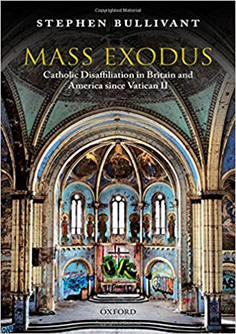Catholic Medical Quarterly Volume 70(1) February 2020
Book Review
Mass Exodus. Catholic Disaffiliation in Britain and America since
Vatican II
by Stephen Bullivant. Oxford
University Press
Reviewed by Dr Pravin Thevathasan
 The
author is Professor of theology and the sociology of religion at St Mary's
University, London. He has written an informative and, in many ways, an
eye-opening account of the current crisis in the Catholic Church.
The
author is Professor of theology and the sociology of religion at St Mary's
University, London. He has written an informative and, in many ways, an
eye-opening account of the current crisis in the Catholic Church.
It is true, says the author, that the Church appeared to be in a healthy state prior to the Second Vatican Council. Mass attendance was high, converts were numerous and vocations plentiful. Catholics lived in tightly knit communities of fellow Catholics. Catholics married Catholics. The Church made demands of the laity and the laity responded by making great sacrifices. Catholics were proud, in the best sense of the term, of their identity. After all, were they not members of the one, true Church?
However, says the author, cracks in the wall were already appearing. Rates of lapsation were such that bishops were compelled to express their dismay. Cultural Catholicism was all well and good but something more was needed to counter the increasing skepticism of the times.
Then came Vatican II. The intention was to produce a well instructed laity capable of evangelizing the world. What actually happened was an unprecedented collapse, especially affecting the Western world. Not only was there lapsation but the rate was staggering. Priests left the priesthood in droves. Nuns left their orders. Mass attendance fell. The pursuit of a certain kind of ecumenism meant that Catholics largely no longer believed they belonged to the one, true Church. Change was in the air, not only in the area of liturgy but doctrine and morality. So many Catholics were critical when Humanae Vitae came out precisely because the teaching appeared to counter the spirit of the age.
After Vatican II, the Catholic Church became an establishment for the educated liberal. Bullivant cites the work of Anthony Archer, an ex-priest who argued that working class Catholics were especially disaffiliated after the Council.
The Council cannot be held responsible for all of the current problems in the Church. But what is clear is that its fruits to date have been far from positive. Emeritus Pope Benedict has often referred to this. In a similar vein, Bullivant rightly concludes that the sex abuse crisis has effectively been a catalyst and not a cause of the crisis.
So, what does the future look like for Catholics? Bullivant quotes the head of the LGBT-rights group Stonewall claiming that it was harder for her to come out as a Catholic than as a lesbian! Little wonder that a Vatican that wants to get on with the world largely welcomes sexual minority groups. If it is difficult for liberal Catholics, how much harder will it be for orthodox Catholics? The book ends with the words: " The story of British and American disaffiliation has, I fear, a while to run."
This is an important work demonstrating that the Catholic Church is indeed in a state of unprecedented crisis, written from a sociological and historical perspective.
